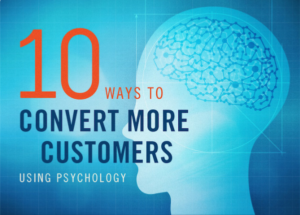When I Googled “Psychology of Sales” several links preceded Daniel Pink’s. Most of them being lists of tricks to use to close the sale, including reverse psychology and hypnotizing (not really, but you know what I mean). All them seemed rather “slimey”. Even without having to click on the links, I was repelled from the articles because we are focused in Sales Class to be authentic and trustworthy when communicating with a buyer. But, for the sake of keeping things interesting, I clicked on the first link in the search results called, 10 Psychology Tricks to Sell Bigger and Faster and it happened to be an infographic. 
Already, it is a little concerning that the goal is to be “bigger” and “faster”. Asking questions, doing research, and reading the room of emotion takes a while. Right off the bat, this article seems not worth the time considering it is not putting the customer’s needs first.
The infographic begins better by saying the 10 ways of selling bigger and faster are based off of research findings that prove the “secret” to selling is giving the customer exactly what she wants. That sings more to the tune of what we learn in Sales. The first tip is one that also aligns with our class lesson – budget. Part of the sales submarine is asking questions that narrow down the customer’s willingness to pay a particular price. In tip 1, salespeople who start low usually get the sale quicker… kind of a no-brainer. Tips 2 through 6 are obvious and not very interesting, however tip 6 deals with pain. Getting the customer to “light up” by adhering to their pain. The flaw in this tip is when it states that you are to constantly remind the customer you can solve their pain. It is not a great idea to assume you know the person’s pain, or that your solution is even the best one they have heard.
Number 9 is the most frustrating. “Dismiss” the customer’s concerns with research and information from your company. Now that just sounds aggressive. Coach D warned us of assuming of the customer’s needs and simply listing off solutions to their problem by almost forcing the customer into the sale. On the contrary, Coach D admitted to be honest with his players and telling them when GCC might not be the right fit. This practice is more honest and it encourages a trusting relationship between buying and selling, rather than jamming your company’s offering down the customer’s throat.
There is obviously a huge difference in the definition of “psychology” between Mr. Pink and this blog post. Daniel Pink focuses on the emotion and thought that goes behind a sales conversation in order to better understand the customers. The end goal is to know the customer’s wants/needs, not to make the sale. For this infographic, making the sale is #1 – the sale will come with the establishment of trust and honesty.

This articles seems to just be manipulative, people should buy products and services because it is of use to them, not because they were tricked.
You did a great job using this article and using what we learned from Coach D to get your point across. Instead of telling that customer what they need, together with the customer you can find out what is best for them and go from there. Overall, great points!